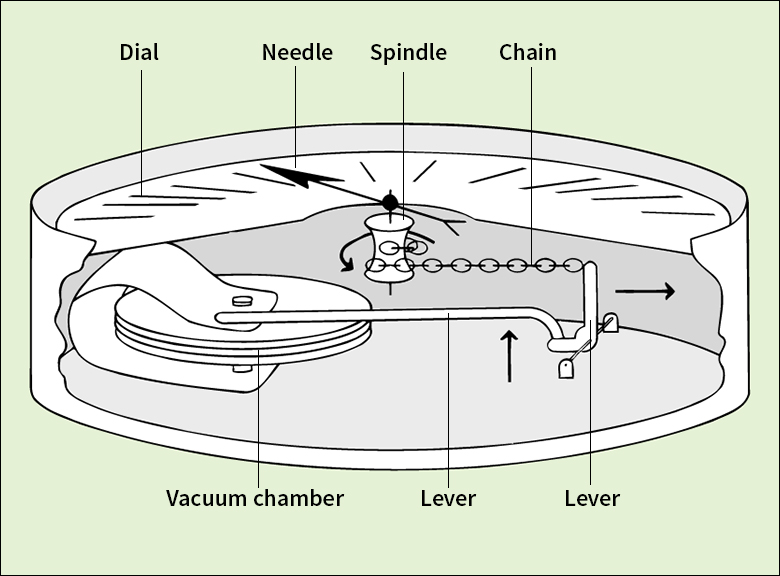Barometer is an instrument that measures the pressure of the atmosphere. Weather forecasters use barometers to detect changes in air pressure. In most cases, such changes indicate that the weather will soon change. Barometers can also be used to measure altitude because air pressure decreases as altitude increases.
The barometer was invented by Evangelista Torricelli, an Italian physicist, who wrote a detailed description of the device in 1644. Torricelli’s device consisted of a long glass tube filled with mercury and inverted in a cup of mercury. The column of mercury in the tube fell until its top was about 30 inches (76 centimeters) above the surface of the mercury in the cup. The pressure of the air on the surface of the liquid in the cup held the mercury in the tube. Torricelli thus showed that the pressure of the atmosphere roughly equals the weight of a 30-inch column of mercury.
Modern barometers measure air pressure in inches or millimeters of mercury or in units called bars and millibars. A millibar equals 1/1,000 of a bar. The bar and the millibar are metric units, though they are not part of the International System of Units (SI), the modern metric system. The SI unit for pressure is the pascal, which equals 1/100 of a millibar.
Scientists record most pressure measurements in millibars. The atmospheric pressure at sea level averages 1,013 millibars, which equals 29.92 inches (760 millimeters) of mercury. To compare measurements taken at various altitudes and temperatures, scientists first adjust them to the values that would be measured at sea level at 32 °F (0 °C).
Kinds of barometers.
There are two main types of barometers—mercury and aneroid.
Mercury barometers
work on the same principle as Torricelli’s device. A mercury barometer consists of a glass tube of mercury with a reservoir at the bottom. Changes in air pressure cause the mercury in the tube to rise and fall. A scale beside the tube indicates the pressure in millibars or in inches or millimeters of mercury. To get an accurate reading, the user must adjust the scale so that the zero point is even with the surface of the mercury in the reservoir. The adjustment is necessary because this surface rises when the mercury in the tube falls, and it falls when the mercury in the tube rises.

Aneroid barometers
are less accurate than mercury barometers but are more sensitive to changes in air pressure. The word aneroid means nonliquid, which indicates that this type of barometer does not use mercury. An aneroid barometer measures the effect of air pressure on a metal chamber from which part of the air has been removed. Changes in air pressure make the chamber expand or contract, moving a needle on a dial. The dial may be scaled in millibars, inches, or millimeters. These light and portable barometers are widely used in homes, offices, and schools, and on ships and airplanes.

Scientists use a type of aneroid barometer called a barograph to record changes in atmospheric pressure. A barograph includes a pen that records the air pressure on a paper chart mounted on a rotating drum.
Uses.
In weather forecasting, the barometer’s chief function is to determine the sea-level pressure and its change. A change in pressure usually means the weather will change. In general, cloudy weather occurs in low-pressure areas, and clear weather occurs in high-pressure areas.
The other major use of barometers is to measure altitude. Atmospheric pressure is lower at higher altitudes because the air there is thinner and has less air above to weigh it down. For example, the average air pressure drops from 1,013 millibars at sea level to about 700 millibars at an altitude of 10,000 feet (3,000 meters) and to about 300 millibars at 30,000 feet (9,100 meters). Pilots use a kind of barometer called a pressure altimeter to determine their altitude. Its scale shows altitude rather than pressure. In addition, hikers and mountain climbers may use barometers to measure altitude.
See also Altimeter; Isobar; Meteorology (How meteorologists measure the atmosphere); Torricelli, Evangelista; Weather.
